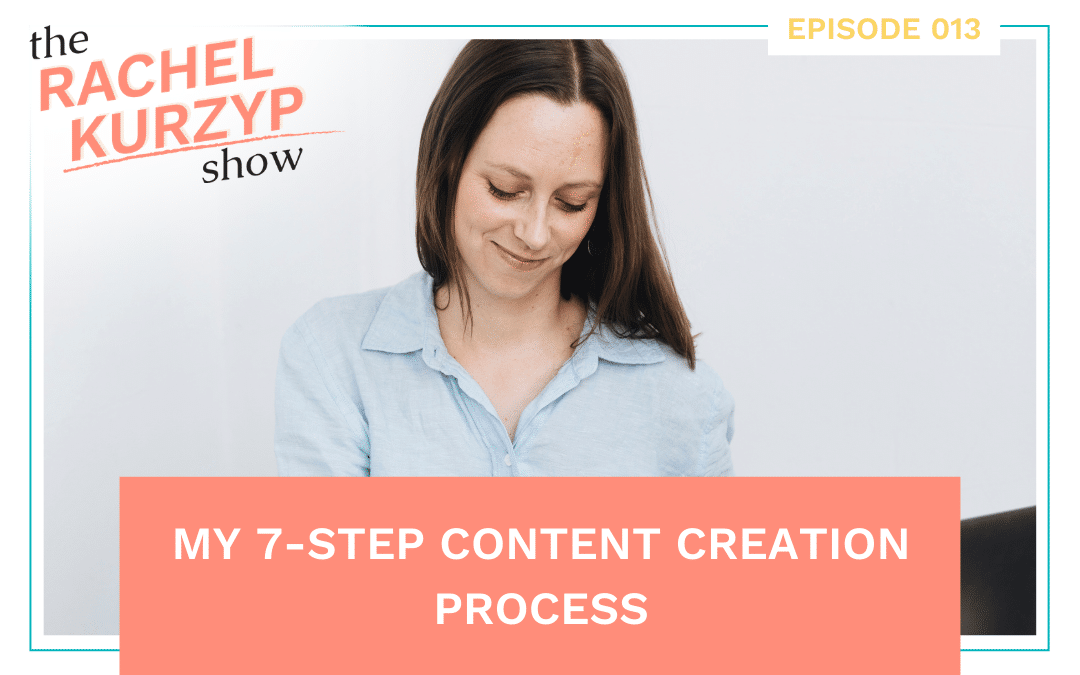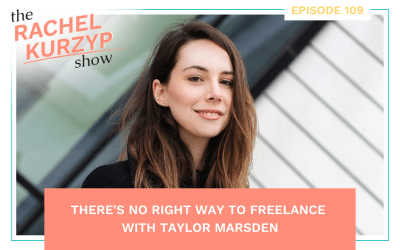Welcome to The Rachel Kurzyp Show
You’re listening to episode 13.
Today I’m sharing my 7-step content creation process.
I often get asked about how I come up with content ideas, do I write headlines first, how many rounds of edits I do, why do I use subheadings like I do, and every question in between.
So that’s what I’m going to cover for you in this episode.
As usual, this episode is jammed packed full of tips so have your notepad and pen handy and make a note of it so you can refer to it on the regular.
Let’s get started!
Step 1 – Always FREE-WRITE without EDITING
The reason why many of you struggle to get binge-me-now words down on the page is because you’re skipping important steps in the writing process. There are five stages of writing:
- Idea generation
- Research
- First draft
- Editing
- Marketing
I won’t go into these in detail today because the writing process needs an ep on it’s own. But what I want you to recognise here is that there are five distinct stages that need to be followed and when you skip the first draft and go straight to editing or marketing (which is what I see many of you doing) that’s when you end up with content that doesn’t feel aligned and doesn’t hit the spot with your clients because the idea isn’t fully developed.
So when you sit down to write your content focus only on writing (close all the tabs in your browser and turn off Grammarly so you can be free to explore your ideas and clarify thoughts. I want you to stop self-censoring by jumping ahead and editing yourself out of the piece before you’ve even started.
And the same goes for coming up with content ideas. I rarely have writer’s or creators block because I’m constantly going through these 5 stages and set equal time for each one.
So I would encourage you to be constantly writing ideas down in your phone or notebook as they come to you.
I have a note saved in my phone where I jot my ideas down and I also save things to Pocket when I’m scrolling through the internet and something captures my eye.
And I’d also encourage you to set 1-2 hours a month to exploring these ideas before choosing which ones to pursue.
Step 2 – Understand WHY you’re WRITING the piece
What’s its purpose? What do you hope to achieve?
Maybe you’re sharing a new product with your dream clients, or you’re writing website copy for a client.
Do you want to share your journey, inspire, educate, or all three? Are you writing Facebook Ad copy, a weekly newsletter, or a blog post?
Knowing the answers to all these questions will help you determine word length, style, format, and tone.
Jot your answers down at the top of the page and use them to give your writing direction. That’s what I used to do when I was a copywriter and that’s still what I do now.
You never want to get to the end of your writing session and be like, “what am I creating this for again?” And have to delete half of the content you’ve written or completely start from scratch because it’s not suitable.
Remember: Writing freely is good. Writing blindly is not.
Step 3 – Know WHO you’re TALKING to
If you want additional tips on how to get inside your dream client’s head, go back, and listen to episode 10.
But as a reminder, we want to have our readers thinking ‘wow she’s speaking to me!’ and we can only do that when we have a clear picture of who our dream client is, what their current problems are and what they desire.
Knowing these aspects of your dream client will help you use concrete examples in your writing.
For example, you can take copy from this “hey girl, check out my new range of cute and affordable dresses’ to this: struggling to find the perfect dress? My new range of dresses can be tailored to your exact body measurements. Choose from a range of fabrics, styles and detailing, And the best bit? You won’t max out your credit card.
Which one are you more likely to engage with?
Once I’ve included all my key messages, I always make sure my content is customer or dream client centered and that I haven’t made it all about me and my goals – which is really easy to do.
Step 4 – Include a CALL-TO-ACTION
What do you want your dream client to do next? Maybe you want them to sign up to your newsletter, tag a friend or DM you to start the sales process.
Either way, be clear about what action you want them to take once they’ve finished reading. Then spell it out for them. Don’t assume your dream client will know what the next step is. It’s your job to move them down your sales funnel. I always write my CTA after I have written the content so that I’m really clear on the purpose of my content and what I want that next step to be.
Your call-to-action should explain how you intend to solve your dream client’s problem using simple, clear, and practical language. If you want more tips on crafting your CTA you can listen to episode 1.
Remember every piece of content you created needs a call to action – no ifs or buts.
Step 5 – Edit for GRAMMAR, PUNCTUATION and SEO
This is when I complete my editing process.
Every writer has their quirks. And with time, you’ll notice what words you spell wrong in your first draft (I can’t spell accommodate don’t judge me), and what grammar rules you commonly break. I know I have a lot of comma and sentence run-on lovers listening to this ep. If this is you, make a note of your quirks so you can double-check them.
My first edit is where I focus on clarity and structure and ensure the point I’m making is clear. Then I do line edits where I remove extra words, repetition, and reduce prepositions, jargon, and acronyms. And ensure I’m writing in an active voice where possible. I want to note here that you should frame your content in a positive way. What I mean by this is, instead of telling people that shouldn’t do something, tell them what they can do and why.
For example: You can’t eat ice cream before dinner can be reframe to say: ice cream is best enjoyed after dinner as it compliments a savory main
And finally, I add relevant keywords that will help my piece be discovered online.
If you don’t have the luxury of having a second pair of eyes, you can read the piece aloud and then backwards (yes you will sound like something out of the Exorcist BUT it works and stops your brain from skipping over the mistakes. You can also use a free software like Grammarly.
Step 6 – Write a READ-ME-NOW headline
On average, five times as many people read the headlines compared to the body copy. So they’re pretty darn important. A great headline convinces your followers to read your content while a poor one will have them continue scrolling.
So you need to devote a lot of time to crafting your headlines. This is why I always write mine last. Again, I talk about this in more detail in episode 1. But what I do want to share here are a few of my favourite headline formulas, now that you know them, you will see them everywhere.
They are:
How to…
Learn how to…
Using numbers like 7 ways….
And asking a question you know your clients want answered like Do you want my headline formulas?
Step 7 – Think about the LAYOUT
We are scrollers and skim readers, so you need to consider how your content looks on the page.
You need to start using headings, subheadings, lists, short sentences, images, and embrace white space.
Generally, people don’t read more than the first paragraph. For the most part, this has to do with readability. No one wants to wade through a content soup to get to the juicy bits.
Make it easy for your dream client to scan your content and recognise the important stuff by breaking up the text.
This is where your headline and call-to-action come in. Think of them as bookends on either side of your copy.
And think of your subheadings, emojis or bold and capitalised words as signposts, guiding your dream client through the story.
Your design should help your dream client get from point A to point B without getting distracted, confused or bored.
I play around with content layout a lot and often make changes to how I display my content based on feedback I get like people not reach the end of my blog posts or wanting enrol buttons at the top of sales pages.
So again, spend time laying your content out and don’t just copy and paste a chunk of text into your IG posts, emails and so on.
There you have it, my writing process broken down into 7 easy-to-follow steps. It’s my hope that by sharing this today, you can implement the same writing process in your business saving you time, energy and creativity that can be used for other important business activities.
And if coming up with ideas of what to post is holding you back, download my free guide 7 types of content to convert followers into clients.
Head to rachelkurzyp.com.au/7contenttypes to get your copy.
I’ll walk you through what content to create and show you how to put the tips I’ve shared with you today into action through real life post examples.
Thanks so much for tuning into today’s episode.
If you’ve found what I’ve shared valuable please leave a review and hit the subscribe button so you don’t miss when a new episode drops every Wednesday.





